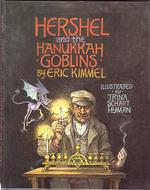This post originally appeared on the Engage/Teacher to Teacher blog in December 2011.
 Eric A. Kimmel is the author of over one hundred books for children, including such well-loved classics as Anansi and the Moss-Covered Rock and the Caldecott Honor Book Hershel and the Hannukkah Goblins.
Eric A. Kimmel is the author of over one hundred books for children, including such well-loved classics as Anansi and the Moss-Covered Rock and the Caldecott Honor Book Hershel and the Hannukkah Goblins.
First of all, despite what most people think, the classic golem story is hardly traditional.
The usual versions of the story, which show up every few centuries, are little more than brief statements: "Rabbi So-and-So replicated the act of Creation by making a man out of clay." Some versions mention keeping the golem around to do odd jobs. That's all.
The main episodes of the classic tale (The Creation of the Golem/The Golem as Sorcerer's Apprentice/The Golem Defends The Community/The Golem Runs Amok/The Golem is Returned to Clay) originate with a novella written in the 1920s by a Czech writer named Chaim Bloch. It owes as much to Mary Shelley’s
Frankenstein and the tale of
The Sorcerer's Apprentice as it does to any Jewish source. Block crafted his tale using the romantic background of the Prague Ghetto and its most prominent figure, Rabbi Judah Leib ben Bezalel. Rabbi Judah Leib was a major scholar and kabbalist. However, nothing prior to Bloch’s book links him with any golem. Even more interesting, the creation of a golem is traditionally linked to another rabbi, Elijah of—of all places!—Chelm!
Can you imagine The Golem of Chelm? That has possibilities. Maybe I ought to think about it.
Bloch’s tale became a Jewish classic. It was made into a movie. It had become a very well-known story when I was growing up in the 1950s. Our Hebrew school library had an English version of Bloch’s novella. I came across it one day, checked it out, and read it in an evening. I must have been in the fifth grade at the time. I was a great reader. I loved the story from that moment because it was so wonderfully creepy. It literally is the Jewish
Frankenstein.
The idea of retelling it as a Hanukkah story wasn’t my idea at all. My dear friend and editor, Margery Cuyler, suggested that I think about writing a golem story. I didn’t think that was a good idea. That story had been retold many times. I.B. Singer wrote a version. As far as I was concerned, the definitive golem is David Wisniewski’s. He nailed it with his text and amazing illustrations. What a genius! I couldn’t do better than that. So I told Margery, “Why bother?”
She persisted. I decided that if I was going to do the story, I’d have to come up with a different angle. A warm, fuzzy golem, perhaps? I began playing around with ideas. Maybe do it as a Hanukkah story? Thinking of
The Sorcerer's Apprentice and especially of Tomie de Paola’s
Strega Nona, I started mapping out a simple plot. The golem starts making latkes. Nobody’s around to supervise. The golem keeps making latkes until they flood the city. Then they have to eat them all to get rid of them.
Once I had that outline, the rest was easy. Rabbi Judah Leib actually was an associate of the Habsburg emperor, Rudolf. Basha, the maid, is a kewpie doll. She does not intend to work any harder than she absolutely has to. Aaron Jasinski’s golem looks like Gumby. He’s perfect. I love the way the book turned out. It was lots of fun to write.
In addition to Golem's Latkes, you’ve written several stories about Jewish holidays, including the Caldecott Honor Book Hershel and the Hannukah Goblins, Even Higher!: A Rosh Hashana Story, and the Story of Esther: A Purim Tale. You’ve even got The Mysterious Guest: A Sukkot Story, about the lesser-known Jewish harvest festival. What draws you to write about these celebrations and traditions? 
I write about them because I love them. I went to a fine Hebrew school where we received a thorough grounding in Jewish traditions. Bible stories, legends, folktales were an important part of the curriculum. Also, the immigrant generation was still alive. My grandma lived with us. She could easily carry on a conversation in five languages. English, however, wasn’t one of them. I was bilingual as a child. I heard lots and lots of stories from my grandma in Yiddish. You might say I got them from the source.
Good stories are meant to be shared. Since I’m a writer, why not share the stories I love best? However, stories are never static. They intertwine. That’s what happens when I’m writing.
Hershel and the Hanukkah Goblins owes as much to Dickens’
A Christmas Carol as it does to the Hershele Ostropolier stories.
Even Higher! is a classic story by the Yiddish master I.L. Peretz with a bit of tweaking at the end that I owe to Trina Schart Hyman, whom I will always adore and admire. “Eric,” she once said to me, “I need something to draw.” It’s not much of a story if I end it with an old lady lying on a pile of rags as she does in Peretz’s original version. So I pulled her out of bed and made her dance.
I came up with
The Mysterious Guests one night when I was stranded in a hotel room in Cherry Hill, PA. There was a power outage and all the lights went out. The elevators weren’t running. I had nothing to do but sit in the dark and look out the window. It was in the fall, shortly after the Sukkot holiday. I began with a famous story about two brothers who exceed each other in kindness and went from there. The two brothers in the story are actually me and my brother Jonathan. Total opposites. I’ll let you guess who was the model for the good brother. Jonny may disagree.
The Story of Esther is right out of the Bible. The idea of doing it came from my editor at Holiday House, Mary Cash. Mary was invited to a Purim party. Being a book person, she looked for a book to bring as a gift. She thought a picture book version of the story of Esther would be perfect. Unfortunately, she discovered that she couldn’t find one in print! There wasn’t one to be found in New York. Mary called me up immediately and suggested I write one. Fast!
I had always assumed that there were several versions around. I was as surprised as Mary was to find there were none available. I sat right down and got busy. I didn’t have to work out the story, so it didn’t take long to write. Maybe a day. It’s one of my favorite stories. It has everything: sex, violence, a damsel in distress, and a villain who gets just what he deserves—which, unfortunately, hardly ever happens in real life.
We have to ask: what is your favorite holiday book?
That’s easy. Charles Dickens’s
A Christmas Carol. I’ve loved it since I was seven years old and saw the Alastair Sim movie. I’ve read and reread it countless times. Dickens takes the trite and sentimental and makes it dark and creepy. It’s scarier than
Twilight. “I wear the chains I forged in life!” Think about it.
Folk tales factor strongly in your work. Do you have any tips for teachers looking to incorporate traditional stories into their lessons?
The best advice I can give is to focus on the story. It’s a story, not a lesson. Stories are about characters who interact. How do they treat each other? How do they face difficulties? How do they solve problems? What do we learn from them that we can apply in our own lives? Let’s talk about that after we listen to the story.
I didn’t write
Hershel and the Hanukkah Goblins to teach children about Jewish customs and ceremonies. I wrote it because I want them to recognize that there is real evil in the world. How do we deal with it? How do you recognize it and respond to it when it shows up in your own life? Because I guarantee that sooner or later it will.
Here’s another way to look at it. A young man in the marching band just died in a hazing incident at Florida A&M. Bullying is finally being recognized as a real problem among school age children. Nobody can haze you or bully you unless you and others cooperate by going along with it; by not taking measures to stop it; and by looking the other way when you see it happening. When you confront the goblins and refuse to play their game, their power disappears. The only power they ever had was the power our own fear gave them.
What just happened in Tunisia, Egypt, Libya, and now Syria are similar examples. One by one, within a span of months, we’ve seen entrenched dictatorships totally collapse once people stopped being afraid and began using the power they always had.
Was the king of the goblins really that terrifying? Or did he just pretend that he was? Maybe he had no more power than the little goblin who shows up at the beginning. He just made a bigger noise.
Dig deep. A good story will always give you plenty to talk about.
You have to love the story. That’s the key. Which stories should you share? The ones you love. It’s your love of the tale that makes it come alive for the children. If you don’t know where to begin, start with the old favorites:
Cinderella,
Snow White,
Puss in Boots. Don’t assume that children know them. They don’t, or if they do, they only know them through movie or cartoon versions. Disney’s Pooh is not Milne’s Pooh. The recent film
Puss in Boots, as much fun as it is, is not Perrault’s
Le Chat Botte. Don’t believe me? Read the real Milne or the real Grimm or the real Perrault and we’ll talk.
There’s a “Hear a Story” section on your website, where kids can look at the illustrations of your books while you read them aloud. What are the most important elements in crafting a good read aloud?
It’s all in the language. A book has to read well. Words have music. A well-written book sings. The best compliments I’ve ever received about my writing comes from teachers who tell me that they enjoy reading my books “because they sound so good!” If you’re not sure what I mean, read a few stories aloud. You’ll hear the difference. Good writing has grace, elegance, wit, style. Bad writing lies flat on the page. You might as well be reading a tax form.
Good books are those you want to read again. Good stories are those you want to hear again.
It’s that simple.